Where is Tympanic cavity/midle ear located? Whatis its shape and dimensions?
Location: The middle ear or tympanic cavity is a narrow slit-like air-filled cavity located inside the petrous part of the temporal bone.
Dimensions:
- Vertical: 15 mm.
- Anteroposterior: 15 mm.
- Transverse: At roof: 6 mm, in the middle: 2 mm. and at the floor: 4 mm.
Shape: It resembles a biconcave disk.
Name the Regions/Stuctures with Which Tympanic Cavity Communicates.
The middle ear communicates:
- Anteriorly with nasopharynx via pharyngotympanic tube/auditory tube.
- Posteriorly with mastoid antrum and mastoid air cells via aditus to antrum.
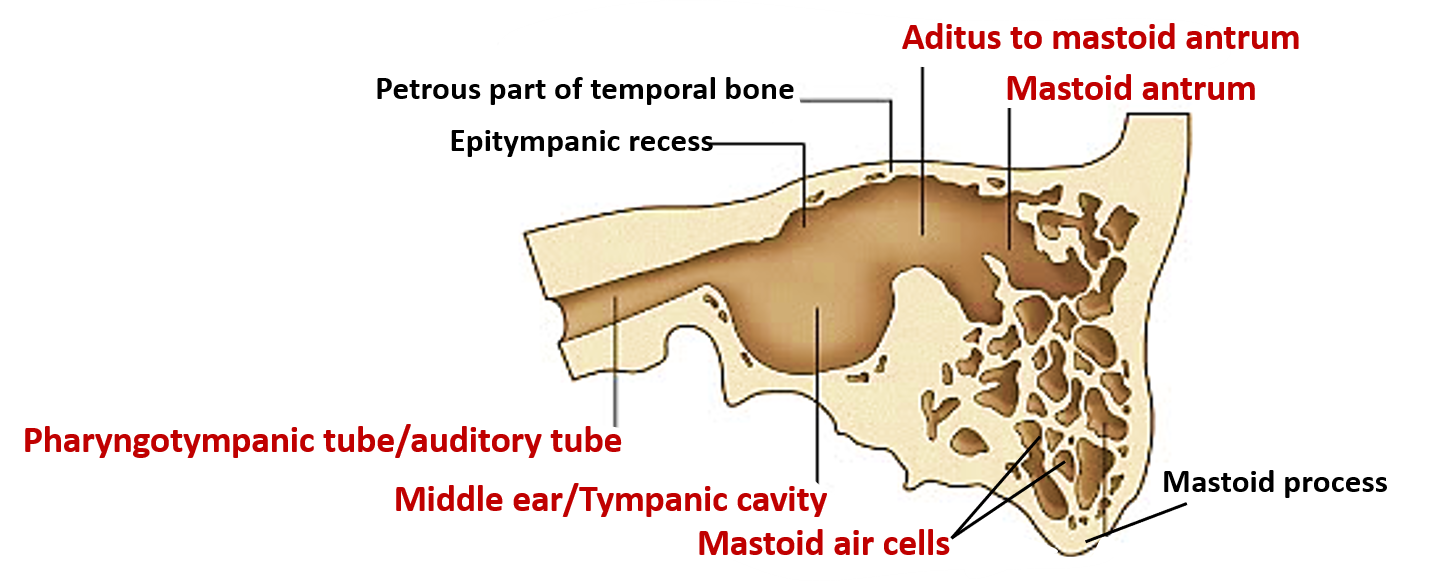
Enumerate the Contents of Tympanic Cavity or Middle Ear.
Following are the contents of tympanic cavity.
- Three ear ossicles: malleus, incus and stapes.
- Two muscles: tensor tympani and stapedius.
- Nerves: chorda tympani (br. of facial N.) and tympanic plexus (formed by br. of glossopharyngeal and caroticotympanic nerves from sympathetic plexus around internal carotid artery).
- Blood vessels: Anterior tympanic artery (branch of maxillary artery) , Stylomastoid branch of posterior auricular artery.
- Air
Air is the actual content. All other contents are covered by mucous membrane.
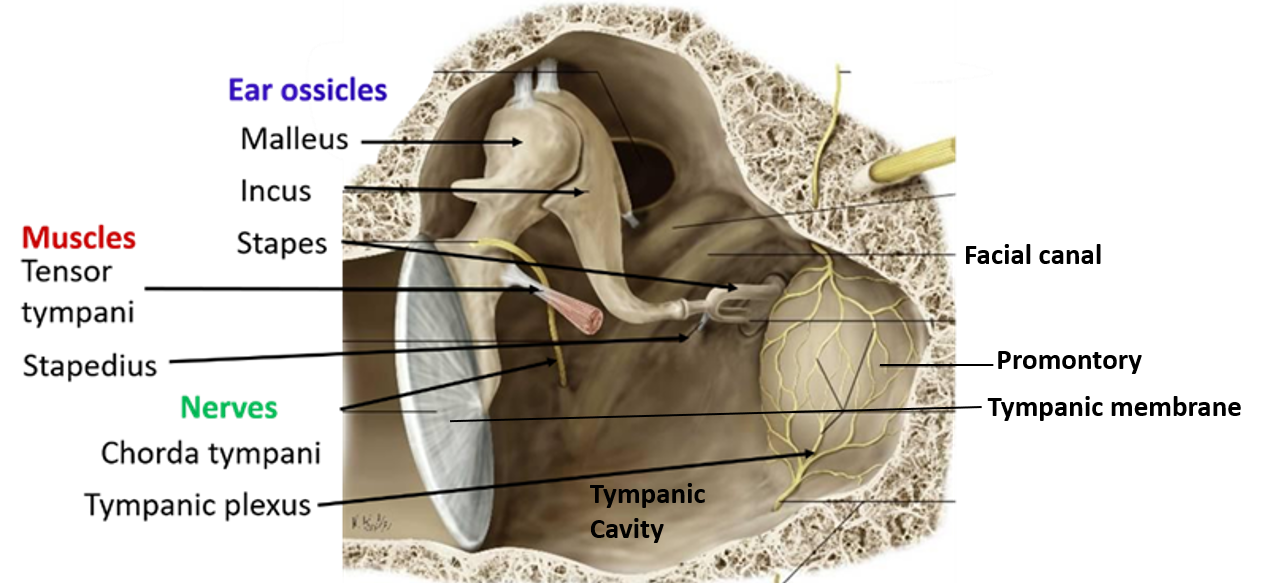
What are the Parts of Ear ossicles?
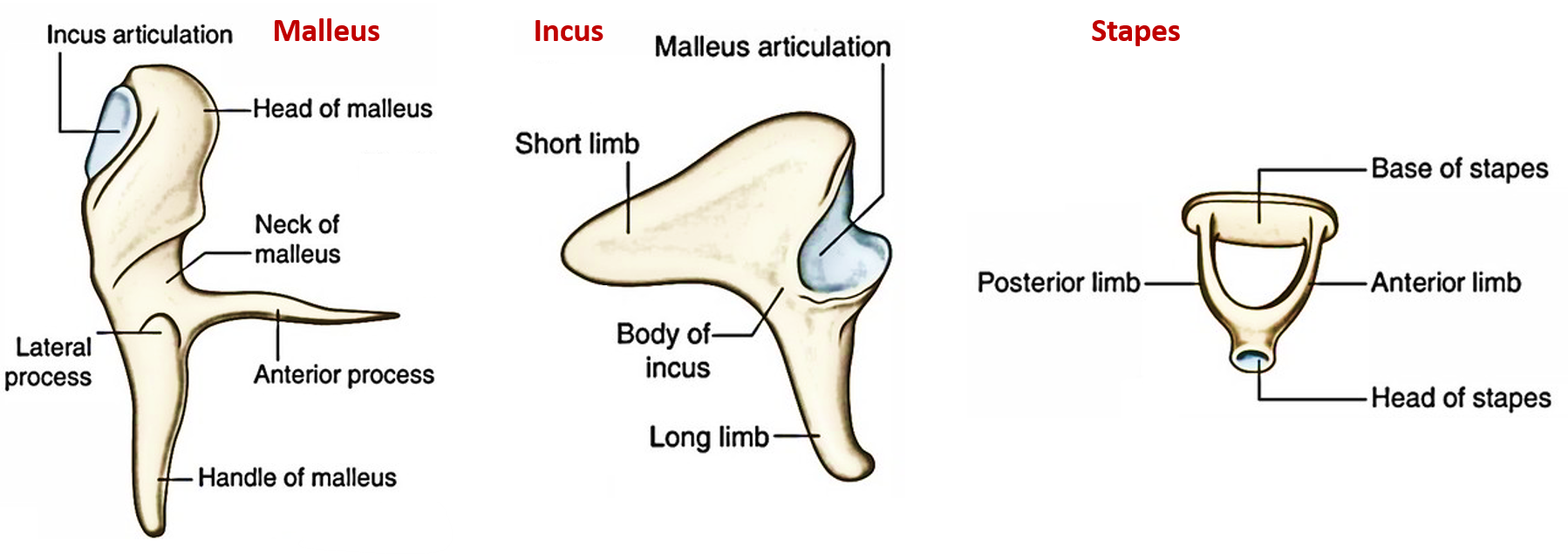
What is the Origin, Insertion, Action and Nerve Supply of Muscles of Tympanic Cavity?
| Muscle | Origin | Insertion | Action | Nerve Supply |
|---|---|---|---|---|
| Tensor tympani | Cartilaginous part of auditory tube and adjoining area of greater wing of sphenoid | Handle of malleus | Makes the tympanic membrane taut. | Mandibular nerve (nerve to medial pterygoid |
| Stapedius | Pyramidal eminence on posterior wall of tympanic cavity | Neck of Stapes | Pulls the stapes laterally (dampens the vibrations of stapes, thus helping to control the amplitude of sound). | Facial nerve |
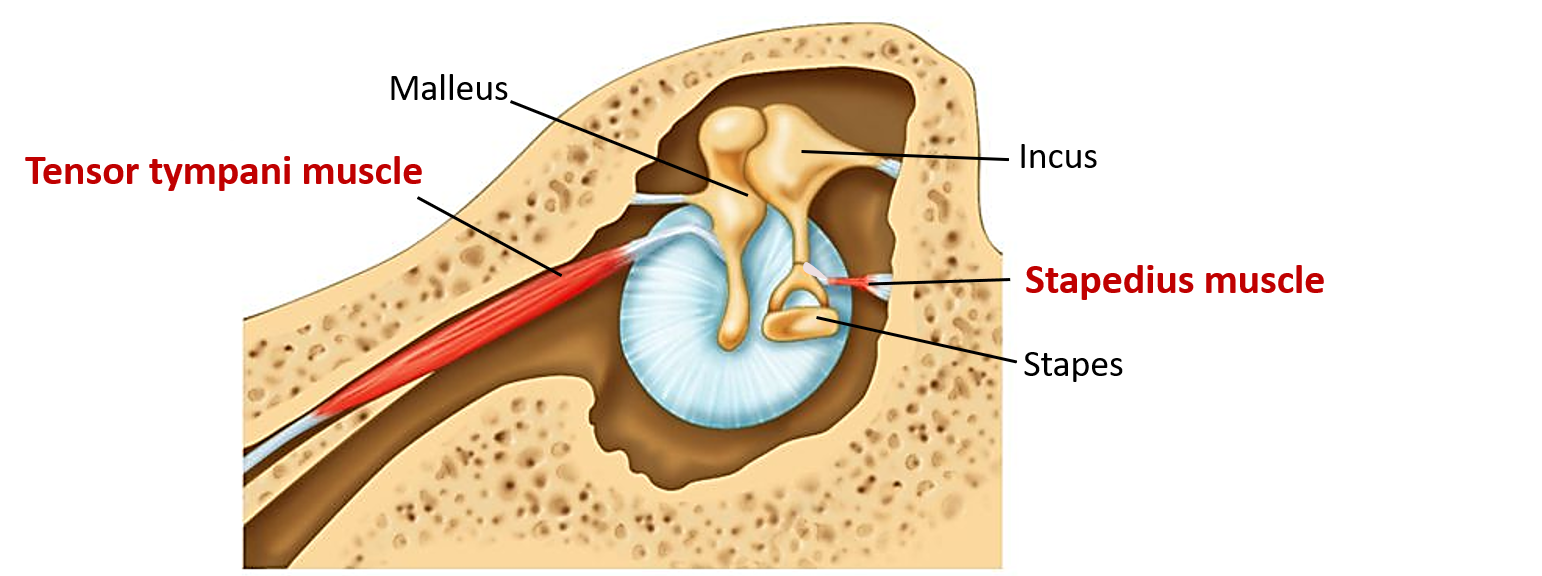
What are the Parts of Tympanic Cavity/Middle Ear?
Parts: Tympanic cavity is divided into two parts:
- Tympanic cavity proper – lies opposite to the tympanic membrane.
- Epitympanic recess – lies above the level of the tympanic membrane. It contains the upper half of the malleus and the greater part of the incus.
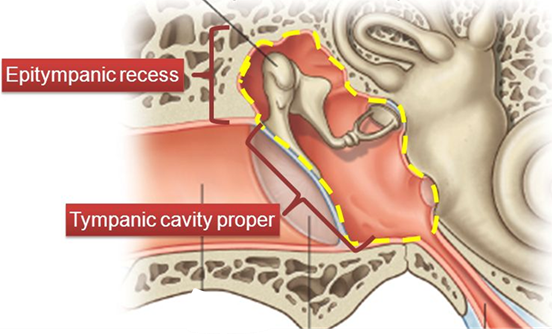
What are the Boundaries and Relations of Tympanic Cavity/Middle Ear?
Tympanic cavity/middle ear is bounded by the following six walls:
1.Roof /tegmental wall: is formed by tegmen tympani which separates middle ear from middle cranial fossa and temporal lobe of cerebrum.
2.Floor/jugular wall: formed by jugular fossa which separates middle ear from internal jugular vein.
3.Anterior /carotid wall: is related to following three structures from above downwards:
- Canal for tensor tympani muscle
- Opening of auditory tube
- Thin sheet of bone separating middle ear from internal carotid artery.
4.Posterior /mastoid wall:
- Aditus to mastoid antrum leads to mastoid antrum and mastoid air cells.
- Facial nerve runs in facial canal along the medial part of posterior wall.
- Pyramidal process projecting from posterior wall gives origin to stapedius muscle.
- Chorda tympani a branch of facial nerve, leaves emerges from facial canal through posterior canaliculus.
5.Lateral /tympanic wall: is formed by tympanic membrane. Chorda tympani passes across the tympanic membrane.
6.Medial /labyrinthine wall: separates middle ear from the internal ear. It presents following features:
- Promontory formed by basal turn of the cochlea.
- Fenestra vestibule (oval window)
- Fenestra cochlea (round window)
- Prominence of facial canal.
- Prominence of lateral semicircular canal.
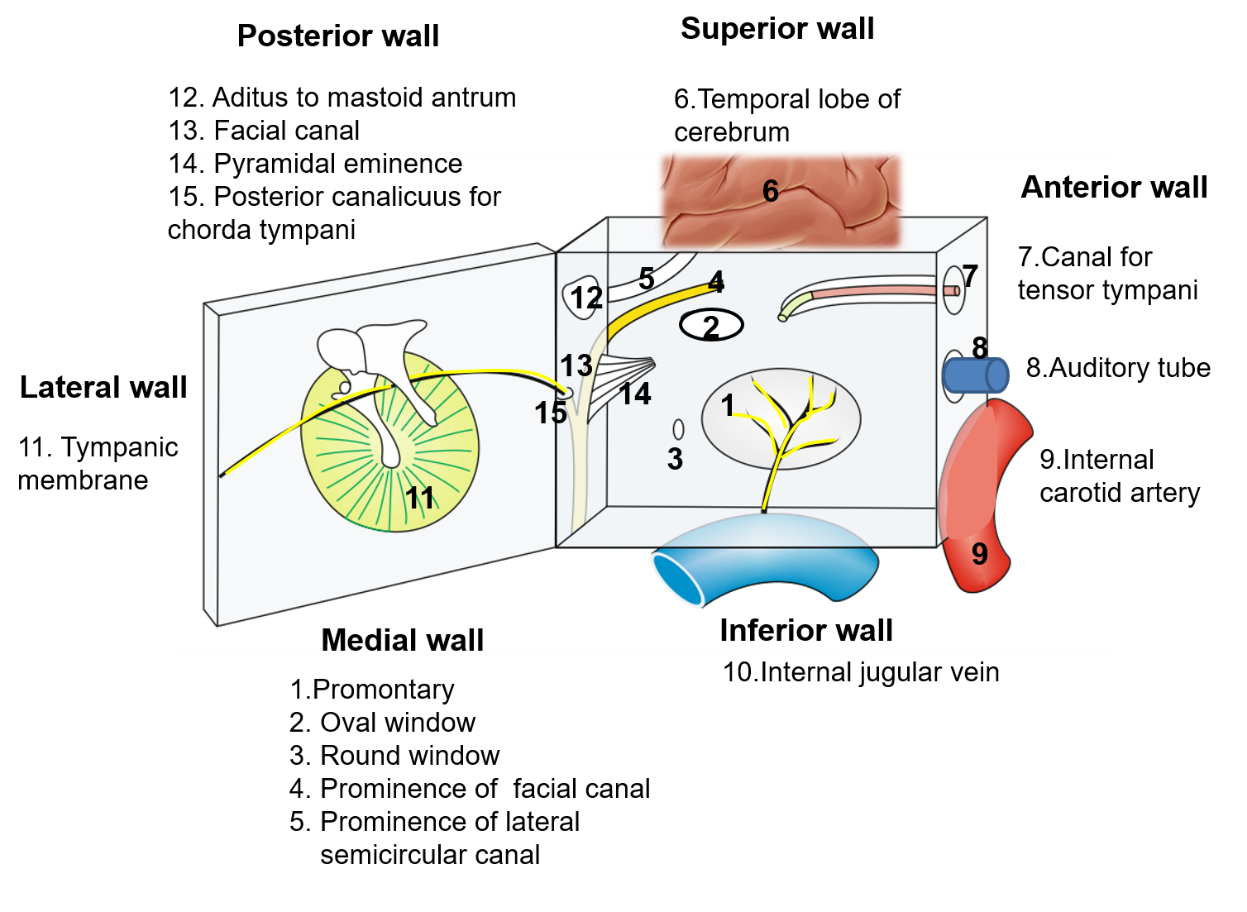
Describe the Blood Supply, Lymphatic Drainage and Nerve Supply of Tympanic Cavity.
Arterial Supply: Following arteries supply the middle ear:
- Stylomastoid branch of occipital artery.
- Anterior tympanic and deep auricular brances of maxillary artery.
- Superior tympanic branch of middle meningeal artery
- Inferior tympanic branch of ascending pharyngeal artery.
- Caoticotympanic branches of internal carotid artery.
Venous drainage: veins from the middle ear drain into pterygoid plexus of veins and superior petrosal sinus.
Lymphatic drainage: lymphatics from middle ear cavity drain into parotid and upper deep cervical lymph nodes.
Sensory Nerve supply: It is derived from the tympanic plexus, which is located on the promontory. Tympanic plexus is formed by:
- Tympanic branch of glossopharyngeal nerve.
- Superior and inferior caotico-tympanic nerves derived from sympathetic plexus (from T1 spinal segment – synapse in superior cervical ganglion) around the internal catotid artery.
Applied Aspects
Fracture of roof (tegmen tympani) of tympanic cavity
It may cause rupture of tympanic membrane. Discharge of blood and CSF occurs from ear.
Otitis media
Infection of middle ear Infection occurs through auditory tube. It may cause perforation in tympanic membrane. Complications of suppurative otitis media include meningitis, mastoditis, internal jugular vein thrombosis.The spread of infection from the middle ear may cause the following:
- Acute mastoiditis and mastoid abscess: when infection spreads into mastoid antrum and mastoid air cells via aditus to mastoid antrum.
- Meningitis: if infection spreads upwards via the thin roof of tympanic cavity (tegmen tympani).
- Facial palsy (lower motor neuron type): when infection erodes the thin bony wall of facial canal.
- Transverse and sigmoid sinus thrombosis: when infection spreads via the floor of tympanic cavity.
- Labyrinthitis: if infection spreads across the medial wall. The labyrinthitis causes vomiting and vertigo.
Otosclerosis
Fixation of stapes to oval window: conduction deafness.
